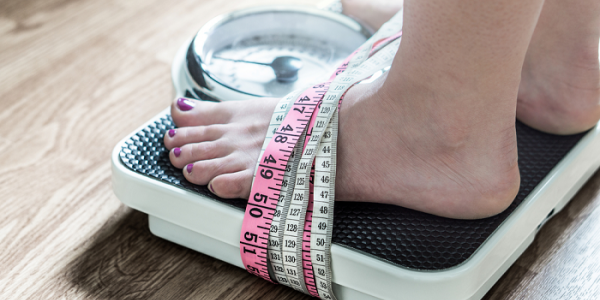Kids don't need to diet. Ever.

How to protect your children from food and body shame. And from the harmful practices of diet-leader.
You may have heard. The multi-billion-dollar corporation with the most popular diet in the multi-billion-dollar diet industry (hereafter referred to as "diet-leader") is doing their best to hook children into weight cycling early. With stock prices down and stiff competition in their industry, diet-leader needed to expand their base of lifelong customers. Under their new guise of wellness, diet-leader launched an app targeted at children ages 8 to 17 in August of this year. Sure enough, their earnings are up—like the numbers on the scale after the diet, only quicker.
Why not help kids lose weight? It seems like a good idea in this fat-shaming world to help kids slim down. Here’s why it’s not:
Like adults, children who diet end up at higher weight: Best evidence in the literature says that adults who diet have temporary weight loss and long-term weight gain (Mann et al., 2007). Further, looking at the literature on diet-leader’s new target group, teens who diet are set on the path of higher body weight than those who don’t diet (Neumark-Sztainer et al., 2007). It seems improper to use the word “diet” when speaking of infants, toddlers, and preschoolers, yet restriction happens even with young children. In their zeal to keep their kids from being obese, parents use restrictive feeding practices when their babies are fat (Brown & Lee, 2011) or they think they may become fat (Faith et al., 2004). Restriction of food during infancy predicts lower weight at age 2 years of age (Farrow & Blissett, 2008) and higher weight by 5 years of age (Farrow et al., 2011). What looks like success in early life becomes detrimental to children’s ability to regulate their food intake when older (Mitchell et al., 2013).
Children who diet develop disordered eating at a high rate: Over one-half of teenage girls and nearly one-third of teenage boys use unhealthy weight control behaviors (skipping meals, fasting, smoking cigarettes, vomiting, taking laxatives) (Neumark-Sztainer, et al., 2006). Children who diet have an exponentially higher risk of developing eating disorder than those who don’t diet (Golden, 2016). Alarmed by diet-leader's new product, eating disorder professionals and parents signed letters and petitions by the thousands, expressing their concerns directly to diet-leader. Yet diet-leader doubled down under the criticism. Here's what diet-leader’s CEO had to say: “It actually strengthened our resolve and made us offensive.” Actually, it's offensive to lead our kids into the diet world with an app that seems like a game.
Pressure to eat good foods and to not eat bad foods backfires: Trying to get kids to eat food categorized as good is associated with decreased liking for and consumption of those foods (Galloway et al., 2006). Similarly, foods categorized as bad become more appealing; children will eat them even in the absence of hunger (Carper, Fisher, & Birch, 2000). Diet-leader’s food categorization system dressed up in kid-friendly technology does this very thing—for every food!
In solidarity we can protect our kids from food and body shame. We can do our level best to prevent the spectrum of problems related to eating and weight. Your influence as a parent is powerful. Consider these 15 recommendations from Marci Evans, Certified Eating Disorder Dietitian Nutritionist:
- Have as many family meals together as you can. Worry less about nutrients and what your child puts on their plate and more about enjoyment and together time. When children are in a low pressure environment, with access to a wide variety of foods and positive parental modeling, they tend to do just fine with their eating over time.
- Have fun with food! Let your little one get messy while exploring something they’ve never tried before. Invite your kids into the kitchen to help with food prep even though it will make the process twice as long. Skewering veggie kabobs and dipping chicken into breadcrumbs is fun for an 8 year old!
- Follow the Ellyn Satter approach to a feeding relationship. As parents your job is to decide what you serve, when, and where. Your child’s job is to decide if they eat and how much. I love this post by Crystal Karges on the topic of trust-building with food.
- Model balanced eating. The best way to inspire children to develop a varied appetite is to eat a wide variety of foods in front of them. You don’t have to talk about it or make it “a thing.” Just live your life, eating everything from oatmeal to broccoli to cookies.
- Steer clear of pressure and the “2 more bites” approach. Pressuring your child to eat certain types of foods often backfires and begins to imprint a “good food, bad food” list in their head. They begin to realize “wow, zucchini must really suck if Mom is working THIS hard to get me to eat it!”
- No need to teach children or young kids about nutrition. I know that may surprise you! But concepts like vitamins and protein are way too abstract for kids. We want children connecting to the sensory aspects of eating, helping them connect to their bodies rather than an intellectualized approach to food.
- Do your best to avoid lumping food into categories as healthy, unhealthy, good, bad, etc. This actually makes the “bad” foods MORE appealing and the “good” foods less appealing. And for the more sensitive child, they may feel that they are “bad” if they eat a “bad food” and begin to develop a shame-based identity around eating choices. This can also encourage sneak eating.
- Refrain from associating food choices with body size, even in a joking way. You may not be eating ice cream because you want to lose weight (I’m not advocating this, I’m using this as an example. I hope you eat ice cream with your children) but do not express this to your child. Instead of saying “No ice cream for me, Mom has to get rid of this belly!” say “No thank you, I’m not in the mood for ice cream right now.” Though don't be surprised if your kids are on to you. It's pretty hard to fool children. Consider setting your weight aside while you raise your family.
- The same goes for exercise. Do not imply to your children that you are exercising to lose weight or to make up for what you ate the day before. Choose physical activity you enjoy, and share the fun of movement with your kids: “I had so much fun at my kickboxing class. Want to show me your best ninja kick?!”
- Do not speak about your appearance or size in a negative way. This can be extremely hard to do. You can absolutely fake it until you make it! Children are sponges and it can feel scary to hear what they parrot back to you.
- Keep appearance-based comments to a minimum and strive for neutral comments. As it turns out, compliments can fuel body distress just as much as criticism. Of course you can tell your child that they are handsome, kind, smart, creative, etc. But a child who is constantly told how “tiny” or “beautiful” they are may begin to feel a tremendous amount of pressure to remain that way or develop a limited sense of self. Let them know how happy you are to spend time with them and how interested you are in their thoughts and ideas.
- Ask your pediatrician or family health care provider to never discuss your child’s weight in front of them. If they have weight concerns they can discuss it directly with you and privately.
- Remember that children gain anywhere from 20-50 pounds during pre-puberty and into puberty. Some children gain weight very quickly. Some children gain weight before they have a growth spurt. Body changes during this time are normal and attempts to curb childhood weight gain predict eating disorders and higher BMIs in young adulthood. Dieting, also known as weight suppression, is the most important predictor of accelerated weight gain, weight stigma, weight cycling, and eating disorders.
- Focus on cultivating self-care habits for the whole family that have nothing to do with weight. Guiding food or exercise choices to change your child’s weight is most likely going to backfire. The American Academy of Pediatrics agrees.
- Celebrate body diversity. Some parents, with the best of intentions, treat the word “fat” like a bad word, instructing their children to never use it. That’s understandable in a culture that acts as if fat is the worst thing a person could be. Instead, try embracing the word fat as a descriptor, like you would short or brown-eyed. That way when your child calls their sibling fat in an attempt to be mean you can say something like, “Emma isn’t actually fat. But there would be nothing wrong with her if she were. In our family we know that bodies come in all sizes and shapes. And we love each other regardless of what our bodies look like.”
Protecting our children from the harms of the world is complicated. Having an approval (or disapproval) process for downloading apps is one way to intervene. Children can learn and maintain a positive relationship with food and their bodies at home under the gentle guidance of their parents.
References:
Carper, J. L., Orlet Fisher, J., & Birch, L. L. (2000). Young girls’ emerging dietary restraint and disinhibition are related to parental control in child feeding. Appetite, 35. doi:10.1006/appe.2000.0343
Brown AE, Lee MD. (2011). Maternal child‐feeding style during the weaning period: Association with infant weight and maternal eating style. Eating Behaviors, 12(2). doi.org/10.1016/j.eatbeh.2011.01.002
Farrow, C. V. & Blisset, J. (2008). Controlling feeding practices: cause or consequence of early child weight? Pediatrics, 121(1). doi: 10.1542/peds.2006-3437
Farrow, C., Blissett, J., & Haycraft, E. (2011). Does child weight influence how mothers report their feeding practices? International Journal of Pediatric Obesity, 6. doi: 10.3109/17477166.2011.575160
Golden, N. H., Schneider, M., & Wood, C. (2016). Preventing Obesity and Eating Disorders in Adolescents. Pediatrics, 138(3). doi:10.1542/peds.2016-1649.
Galloway, A. T., Fiorito, L. M., Francis, L. A., & Birch, L. L. (2006). Finish your soup: Counterproductive effects of pressuring children to eat on intake and affect. Appetite, 46(3). doi.org/10.1016/j.appet.2006.01.019
Mann, T., Tomiyama, A. J., Westling, E., Lew, A.-L., Samuels, B., & Chatman, J. (2007). Medicare’s search for effective obesity treatments: Diets are not the answer. American Psychologist, 62(3). doi:10.1037/0003-066X.62.3.220-233.
Mitchell, G. L., Farrow, C., Haycraft, E., & Meyer, C. (2013). Parental influences on children’s eating behavior and characteristics of successful parent-focused interventions. Appetite, 60(1) doi.org/10.1016/j.appet.2012.09.014
Neumark-Sztainer, D., Wall, M., Guo, J., Story, M., Haines, J., & Eisenberg, M. (2006). Obesity, disordered eating, and eating disorders in a longitudinal study of adolescents: How do dieters fare 5 years later? Journal of the American Dietetic Association, 106(9) doi.org/10.1016/j.jada.2006.01.003
Neumark-Sztainer D., Haines, J., Wall, M., & Eisenberg, M. (2007). Why does dieting predict weight gain in adolescents? Findings from project EAT-II: a 5-year longitudinal study. Journal of the American Dietetic Association, 107(3), 448-55.
Related Articles

Why Not Diet?
Dieting is glamorized and normalized. Weight loss is portrayed as harmless, even helpful. In this article, I make the case for not dieting. Yet, you may be left with the dilemma: If not dieting, then what? There’s help for that. Read on…

Diet Talk Carries On
Talking to kids about diet or about weight...it may seem like a good idea, and may even be the advice from a reliable source. While well-meaning, encouragement to diet passed along from parent to child can have unintended and lasting consequences.

Shrinking Ideas about Diets
Start the New Year by losing the dieting mentality.





